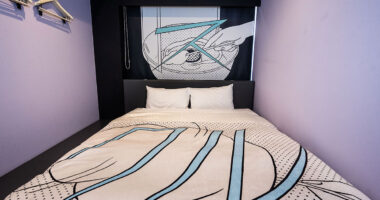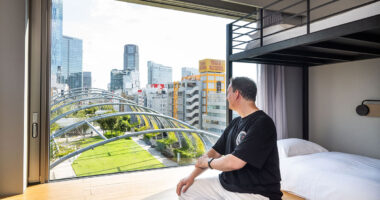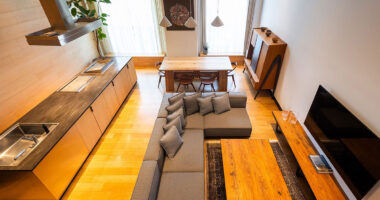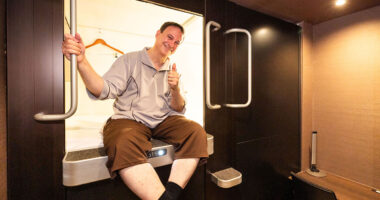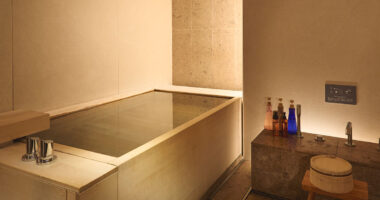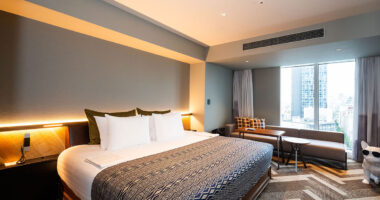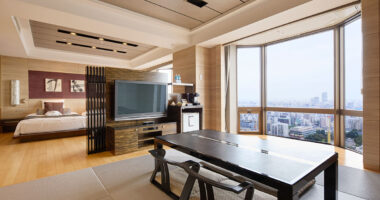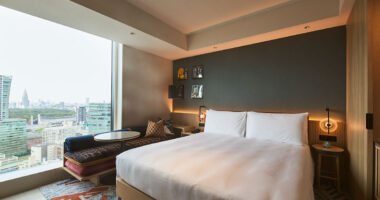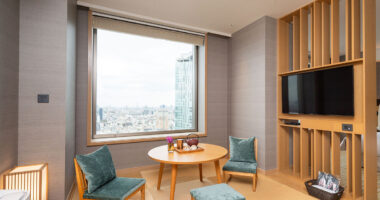Embarking on a journey to Japan offers more than just sightseeing; it’s an immersive experience. One key part of this experience is the country’s diverse array of accommodations. Each type of lodging offers a unique blend of comfort, culture, and charm. This guide will outline the main options at your disposal, organized into the following sections: Japanese Style, Western Style, Family-Run Lodgings, Budget & Social Accommodations, Long Term, and Others.
Japanese Style
When it comes to privately operated accommodations, there are two types allowing you to experience traditional Japanese hospitality:
旅館 ryokan: Ryokans, or Japanese inns, are often located in scenic areas and allow guests to experience tatami-matted rooms. A unique feature of ryokans is the use of futons. Not to be confused with a fold-down sofa, a 布団 futon in Japan is a thick foldable mattresses. In many ryokans, staff will expertly handle taking out your futon from the closet before you sleep and putting them away after you awaken, so there’s no need to turn down your bed. Guests may also wear yukata and traditional Japanese footwear. Ryokans may also have communal baths. Moreover, they often provide locally sourced multi-course dinners. The immersive experience comes with a price range of 15,000 JPY to over 50,000 JPY per person per night, but it’s worth every yen.
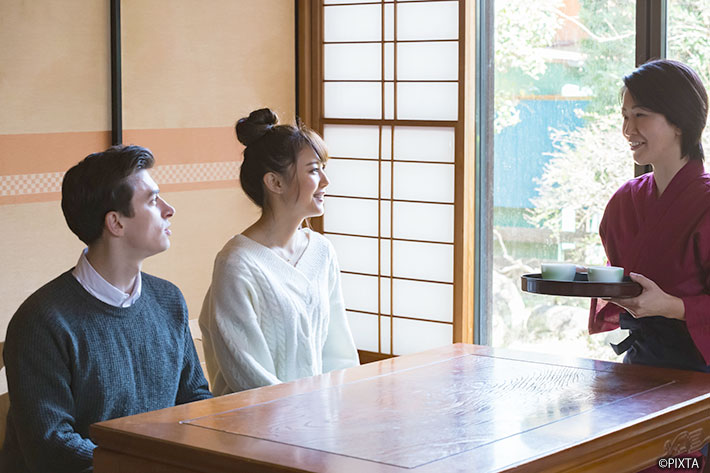
Staying at a ryokan will give you a taste of traditional Japanese hospitality.
宿坊 shukubō (Temple Lodging): For a spiritual retreat, try shukubō. You can experience the monastic lifestyle with morning prayers and traditional vegetarian monk’s cuisine. Participation in temple activities is often optional and suitable for all. Located in temple towns like 高野山 Kōyasan in Wakayama Prefecture, these lodgings can cost as little as 6,000 JPY to upwards of 20,000 JPY per person per night, meals included.
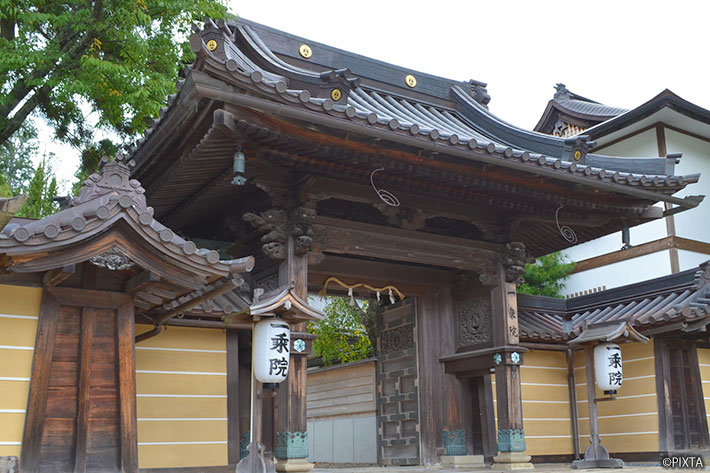
一乗院 Ichijō-in Temple in Kōyasan offers shukubō lodgings.
A note on tatami matting:
One thing to keep in mind when staying in a traditional Japanese building with tatami matting, whether it’s a ryokan or a temple, is that you’ll need to remove your footwear before you go in. This also holds true for Japanese restaurants with tatami-matted dining areas. You may be given slippers to wear inside when walking on wooden flooring but these too should be removed when stepping onto the tatami matting. Moreover, if you have suitcases, be sure not to drag them on the tatami but carry them by hand.
Western Style
Japan also offers an array of Western-style accommodations.
Boutique Hotels and Chain Hotels: From budget to luxury, hotels in Japan cater to every traveler. Boutique hotels, known for their personalized service and distinctive style, offer a unique lodging experience. On the other hand, chain hotels provide a familiar standard of service and facilities. Both international and domestic chains are available. Rates can start from around 7,000 JPY for budget options, while high-end hotels can exceed 30,000 JPY per night.
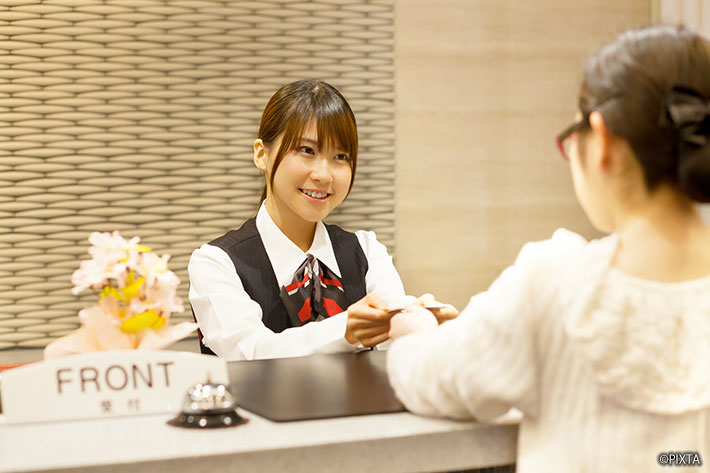
The front desk of a business hotel. (Photo for illustrative purposes only).
Business Hotels: If convenience tops your list, business hotels are your best bet. Located near transport hubs, they offer clean rooms with private bathrooms, starting from around 7,000 JPY per night. Rooms are typically small by Western standards, especially at the lower price range.
Capsule hotels: Capsule hotels offer a unique accommodation experience, with individual pods instead of rooms. Each pod typically includes a bed, a light, and sometimes a small TV or radio. Capsule hotels often have shared bathroom facilities and common areas, usually segregated by gender. They can be a budget-friendly option starting from around 3,000 JPY to 6,000 JPY per night. They are a great option for solo travelers looking for a private space to sleep without the cost of a hotel room.
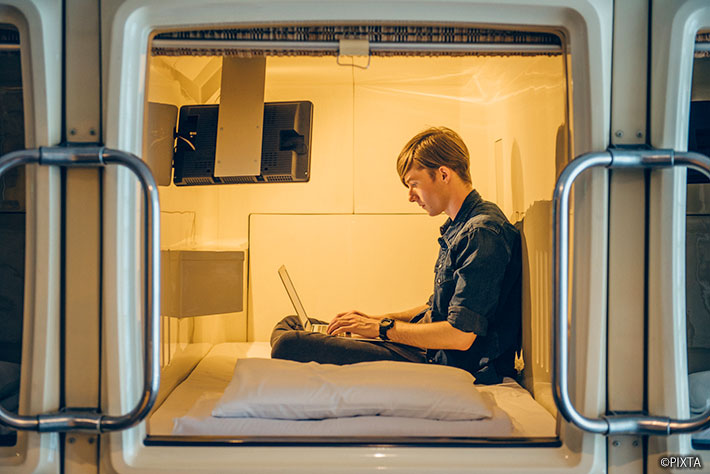
Staying at a capsule hotel in Japan is a unique experience.
Family-Run Lodgings
For a stay that combines the comfort of home with the thrill of travel, consider family-run and private lodgings. Both Japanese and Western style homes and establishments can be found in this category, reflecting the diverstiy of residences in the country.
民宿 minshuku (Family-Run Guesthouses): Often operated by families as a secondary business, they provide simple rooms and home-cooked meals, typically in Japanese-style homes. Farmhouse minshuku are also gaining in popularity recently. You can enjoy beautiful natural surroundings, cute animals and sometimes even join activities such as farm experiences. Prices range from 5,000 JPY to 8,000 JPY per night on average and sometimes above 10,000 JPY for farmhouse minshuku.

A farm experiences are sometimes available at farmhouse minshuku.
Pensions and B&B: Characterized by newer, usually Western-style facilities (although pensions with Japanese-style facilities exist) and family-run labor, pensions are usually situated in natural environments and convenient for sports like skiing or tennis. They are often regsitered as hotels, with prices situated between ryokans and minshuku, around 6,000 JPY to 12,000 JPY per night. Some may follow the B&B model with breakfast-only rates.
民泊 minpaku (Private Home or Apartment Rentals): These privately rented homes or apartments may offer more flexibility in terms of stay duration. Owners are usually happy to offer tips on dining and sightseeing in the area. Pricing can vary widely but typically falls in the range of 3,000 JPY to 10,000 JPY per night, depending on the location and amenities offered.
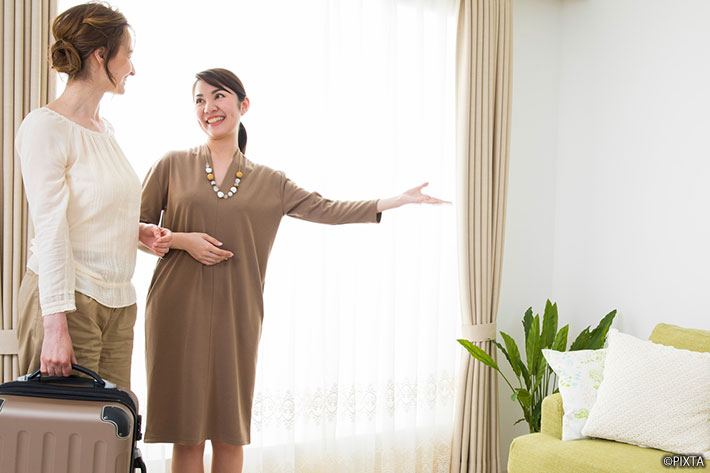
A friendly minpaku owner showing their apartment. (Photo for illustrative purposes only).
Budget & Social Accommodations
Hostels: Hostels are geared towards budget-conscious travelers looking for a simple place to sleep. They usually offer dormitory-style accommodation with shared facilities. The price for a night’s stay in a hostel can range from 1,500 JPY to 4,000 JPY.

Staying at a guesthouse can be a great way to save money. (Photo for illustrative purposes only).
Guesthouses: These are often budget-friendly, providing a communal living environment with private or shared rooms. They typically cater to tourists and short-term visitors. Prices range from around 2,000 JPY to 5,000 JPY per night.
Gaijin Houses: As the name suggests, these houses (sometimes apartments) are designed primarily for 外人 gaijin (meaning “foreigners”). Offering flexibility, they often have options for both weekly and monthly rentals. Weekly rentals might range from 15,000 JPY to 30,000 JPY, while monthly rentals typically start from around 50,000 JPY.
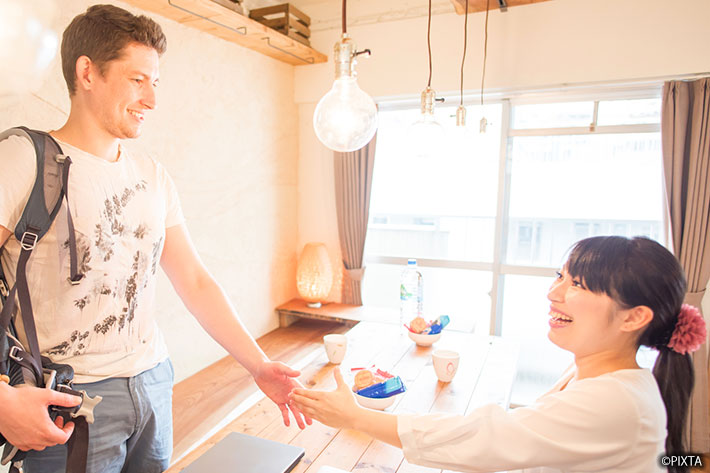
So-called “gaijin houses” are designed to accommodate foreign tourists on a budget. (Photo for illustrative purposes only).
Share Houses: Share Houses are commonly aimed at longer-term residents such as students or working professionals. They often focus on monthly rentals, and the price might range from 40,000 JPY to 100,000 JPY per month, depending on location and amenities.
Long Term
If you’re planning an extended trip to Japan and don’t feel comfortable with communal living arrangements such as share houses, the following options are also available:
Furnished Apartments: If you want to stay for several week in the same spot and need space, a kitchenette and laundry facilities, a furnished apartment could be perfect for you. Tailored for long-term stays, these apartments strike a balance between the convenience of a hotel and the comfort of a home. Furnished apartments are occasionally available for shorter spans such as weekly rentals.
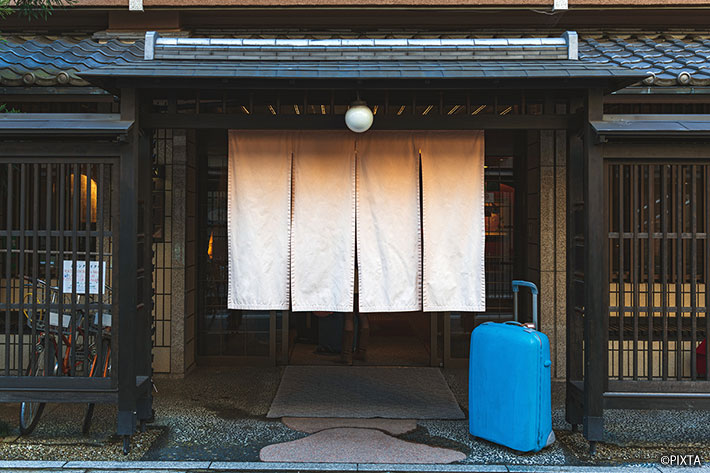
Some traditional houses are available for vacation rentals. (Photo for illustration purposes only).
Vacation Rentals: You can also find furnished apartments specifically designed as vacation rentals, situated in spots popular as summer and winter vacation desinations. While many offer weekly rentals, there are also vacation rentals available for longer terms. In addition to entire homes and condominiums, you can also find 古民家 kominka, Japanese folk houses built before the Second World War, as well as 町家 machiya, traditional wooden townhouses such as the ones you’ll find in Kyoto. Prices range from 60,000 JPY to 250,000 JPY per week, while kominka and machiya will probably command higher prices.
For all the categories mentioned above, please note that prices can vary widely based on the location, facilities, time of the year, and other factors. Always check with the individual provider for the most accurate and up-to-date pricing.
Others
In addition to the accommodation types mentioned above, you’ll also find the following options:
Resorts: Resorts in Japan offer an all-inclusive experience that caters to your recreational needs. Hot spring resorts, both in Japanese and Western styles, are a delight for those seeking relaxation and wellness thanks to the benefits of the 温泉 onsen (hot springs) waters. Beach resorts offer a perfect blend of sun, sand, and sea, with accommodations that range from traditional ryokans to Western-style hotels. Skiing resorts, usually featuring Western-style accommodations like hotels and chalets, are a hit during the winter months. Prices for resort accommodations can vary greatly based on the type of resort, location, and amenities.
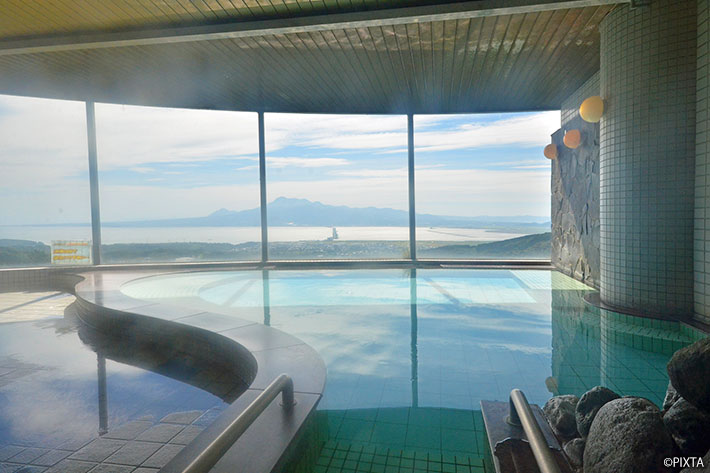
A hot springs resort can provide enjoyment and relaxation. (Photo for illustrative purposes only).
Camping and Glamping: If your ideal vacation involves waking up to birdsong and sipping coffee amidst lush greenery, camping in Japan’s beautiful outdoor settings will be right up your alley. Expect to pay between 2,000 to 5,000 JPY per night, depending on the facilties available. For those who enjoy nature with a touch of luxury, glamping—glamorous camping—offers fully furnished tents and high-end facilities. Glamping facilities are often priced similarly to luxury hotels.
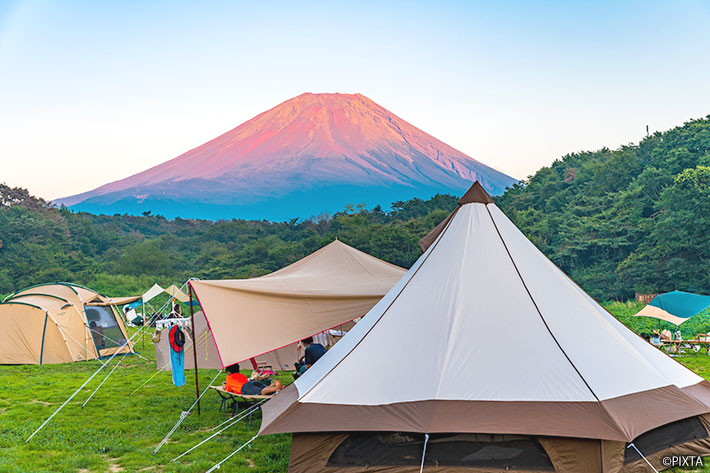
A campsite with views of Mt. Fuji.
In sum, finding the right accommodation in Japan is key to enhancing your travel experience. Whether you’re drawn to the traditional charm of Japanese inns, the diverse styles of Western-style hotels, or anything in between; whether you’re on a budget or seeking luxury; whether you want to explore the city or embrace nature; whether you’re traveling with friends or alone, or whether your stay is brief or extended, Japan offers accommodations to suit every traveler’s desires and needs.

